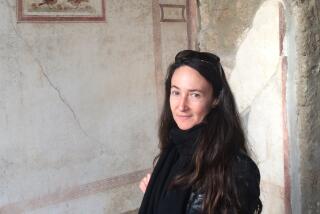BOOK REVIEW / NONFICTION : A Slippery Topic Is Explored Shapelessly : A NATURAL HISTORY OF LOVE <i> by Diane Ackerman</i> ; Random House $23, 350 pages
- Share via
“Love is the great intangible.” So begins “A Natural History of Love,” and for good reason; love is an extremely slippery topic, one certain to resist all attempts at categorization or itemization. It is also, however, a reliable crowd-pleaser, meaning that Diane Ackerman’s follow-up to 1990’s best-selling “A Natural History of the Senses” will likely be a staple on beaches around the country this summer.
And as it turns out, that’s probably the best way to read “A Natural History of Love,” for it is surprisingly shapeless, a miscellany of vignettes and essays that vary between the arresting and the superficial, the illuminating and the irksome.
Reading the book, you spend half your time wishing it were better, and the other half captivated by those passages in which Ackerman, a poet and staff writer for the New Yorker, has found a particularly good lens through which to view her subject. “A Natural History of Love” is divided into six parts, the weakest of which is the first, once-over-lightly chronology of love. The biggest problem with this section is that it should be a book unto itself; it’s impossible to do justice to 2,000 years of history--Ackerman begins with ancient Egypt and ends in modern times--in a hundred pages.
She over-generalizes madly as a result, and although she can be quite interesting when pausing to give detailed discussions of famous lovers such as Cleopatra, Ovid and Abelard, her prose can be informal to the point of flippancy. She calls the Dionysian maenads “punks,” says Orpheus’ music gave them “the willies”; and characterizes Abelard as a “hunk.” It’s difficult to read such descriptions without wondering the degree to which Ackerman has bent and selected history to suit her storytelling needs.
The book’s next section is much better, for here Ackerman analyzes specific texts--the ideas about love found in the work of Plato, Stendhal, Proust and Freud, as well as in the legend of Tristan and Isolde. This is straightforward, congenial literary criticism, and if it hardly summarizes the field, Ackerman at least stakes out the general perimeter.
In the next two sections--subtitled “The Nature of Love” and “The Erotics of Love,” respectively--we’re back on familiar ground, Ackerman producing the sort of comfortable nature writing familiar to New Yorker readers. She tells of anthropologist Colin Turnbull’s sojourn with Uganda’s Ik tribe, so poverty-stricken that members lost the ability to love; the body chemicals oxytocin, phenylethylamine and the endorphins, which create, intensify or sustain love; natural selection that favors the cute and comely; the sexual nature of human hair; and two perennial favorites--the attraction horses hold for women, on the one hand, and the attraction cars hold for men, on the other. These 30 pages on hair, horses and cars are among the book’s best, probably because Ackerman addresses them at length.
By the time persistent, we-never-skip readers have finished “Kissing,” six pages repeated from “A Natural History of the Senses,” they will have completed three-quarters of the new book and read something like 70 bite-size capsules only occasionally linked by meaningful argument. The moment might seem right for Ackerman to begin to wrap things up, to pull her themes and schemes together, but no: The last two sections of the book are a disorienting hodgepodge, Ackerman tossing together essays on topics she apparently hadn’t been able to get to earlier.
She covers courtship, marriage, altruism, crimes of passion, love of pets, and analyst-patient transference, often engagingly but in bewilderingly different ways. Case in point: her account of a mission with Interplast, a medical organization that performs reconstructive surgery on Third World children born with congenital disabilities. The piece is wonderfully moving, full of life and heart--but it’s a magazine article and completely out of place here, even as an example of altruistic love.
It’s too bad “A Natural History of Love” ends as it does, leaving the impression of a writer recycling material, virtually unchanged, into book form. That’s acceptable in a collection of previously published essays, but one expects more from a volume such as this--a consistent tone, a flowing narrative, a sense of a writer with a certain amount of perspective on, and control of, her material.
Word for word, “A Natural History of Love” is a pleasure, but it’s a box of sweets rather than a convivial, satisfying meal. Ackerman can be a beguiling, even seductive writer, but most people who complete the book, I suspect, will conclude that the author and her readers should be just good friends.
More to Read
Sign up for our Book Club newsletter
Get the latest news, events and more from the Los Angeles Times Book Club, and help us get L.A. reading and talking.
You may occasionally receive promotional content from the Los Angeles Times.








